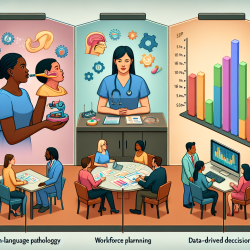Introduction
As a speech language pathologist, the challenge of aligning workforce capabilities with the needs of the population is crucial. The research article "An integrated primary care workforce planning toolkit at the regional level (part 2): quantitative tools compiled for decision-makers in Toronto, Canada" offers valuable insights into developing data-driven strategies for workforce planning. This toolkit can significantly enhance the effectiveness of speech language pathology services, particularly in educational settings where the demand for such services is increasing.
Understanding the Toolkit
The toolkit described in the research focuses on a quantitative model that aligns regional service requirements with the service capacity of the workforce. This model is built on comprehensive data collection and analysis, addressing both population health needs and workforce supply. For speech language pathologists, integrating such a model can ensure that therapy services are efficiently allocated to meet the specific needs of children in schools.
Key Components of the Toolkit
- Population Health Needs: Understanding the demographics, socioeconomic factors, and health status of the population is essential. This allows practitioners to tailor their services to the unique needs of each child.
- Workforce Supply: By analyzing the current workforce, including the availability and scope of practice of speech language pathologists, the toolkit helps in identifying gaps and opportunities for training and development.
- Scenario Analysis: The toolkit supports the simulation of different scenarios, enabling practitioners to predict and plan for future needs effectively.
Application in Speech Language Pathology
For speech language pathologists, this toolkit offers a structured approach to workforce planning. By leveraging data, practitioners can make informed decisions about resource allocation, ensuring that every child receives the necessary support. This is particularly important in schools where diverse needs must be met efficiently.
Encouraging Further Research
The toolkit provides a foundation for further research in speech language pathology. Practitioners are encouraged to explore how quantitative models can be adapted to their specific contexts, enhancing the quality of care provided to children. By engaging with the toolkit, speech language pathologists can contribute to the development of more effective, evidence-based practices.
Conclusion
The integration of a data-driven workforce planning toolkit in speech language pathology can lead to significant improvements in service delivery. By aligning workforce capabilities with population needs, practitioners can ensure that children receive the best possible outcomes. For those interested in exploring this toolkit further, I highly recommend reading the original research paper.
To read the original research paper, please follow this link: An integrated primary care workforce planning toolkit at the regional level (part 2): quantitative tools compiled for decision-makers in Toronto, Canada.










